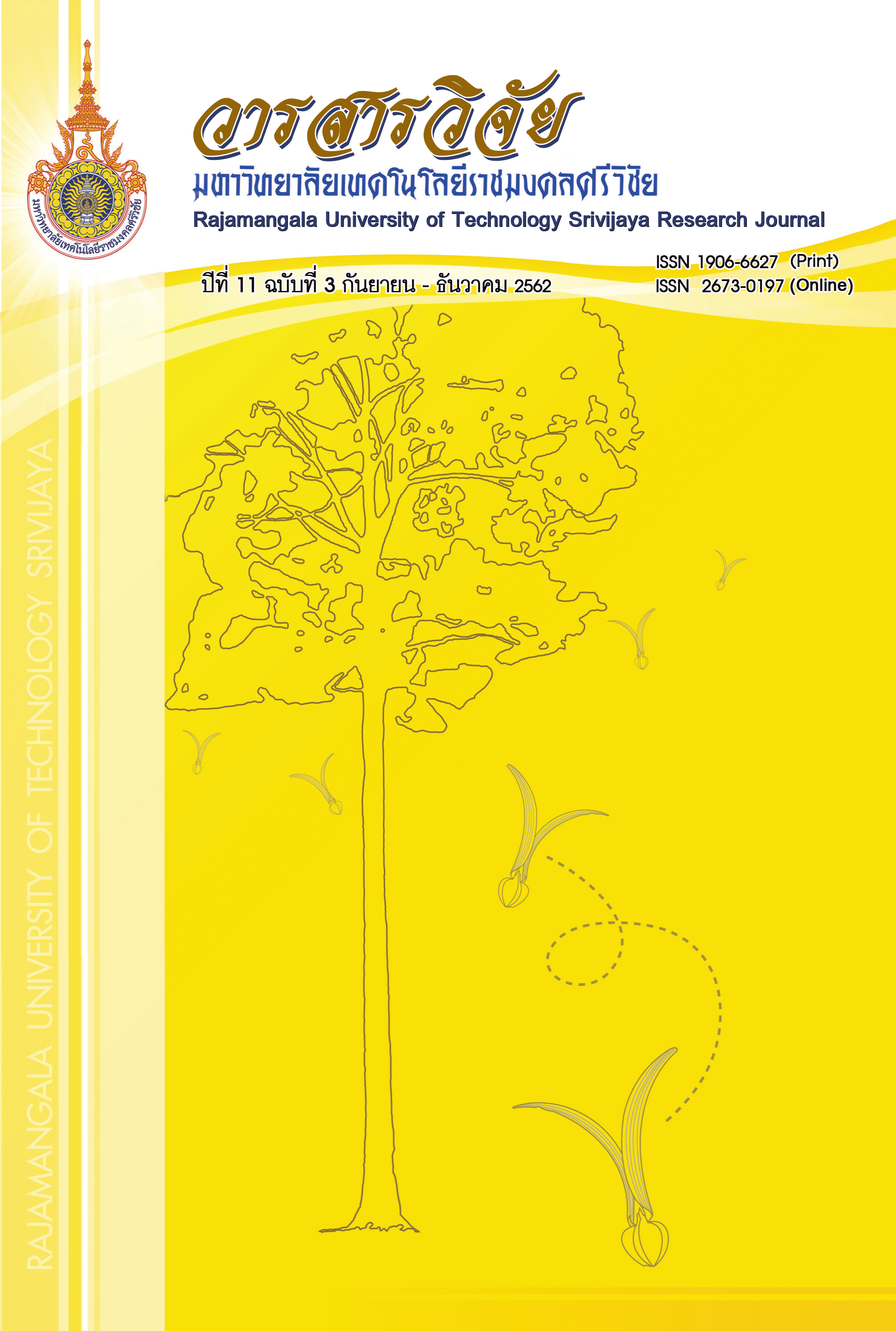Production and Properties of Compost from Organic Waste in Foam Box
Main Article Content
Abstract
This research investigated production and properties of compost from organic waste in foam box. The objectives were determined the properties of raw materials and compost. Researchers especially focus on domestic organic waste such as coffee ground, decanter cake from palm oil industry and residue from rubber processing plant. This experiment investigated 7 different ratios of coffee ground: decanter cake: residue from rubber processing plant as 3:0:0 0:3:0 0:0:3 1.5:1.5:0 0:1.5:1.5 1.5:0:1.5 and 1:1:1. The results of raw materials properties showed that coffee ground, decanter cake and residue from rubber processing plant have the major nutrient for plant growth. Then, they are possible to use as raw material for composting. Aerobic composting process achieved maturing at approximately 30 days observed from temperature pH and EC. The major nutrients for plantation namely; nitrogen, phosphorus and potassium were 0.42-3.20% (w/v), 0.26-1.20% (w/v) and 0.07-2.17% (w/v), respectively. The optimal ratio of 0:3:0 because this ratio has the highest major nutrient for plantation. The characterization of the compost produced in this research was found to be within the acceptable limit of standard from Department Agriculture of Thailand. In addition, researchers were tested Germination Index. It found that the compost is non-toxic for seeds. Then, the compost from coffee ground, decanter cake and residue from rubber processing plant fermented in foam box can produce compost could be used as a soil amendment.
Article Details
The content and information in the article published in Journal of Rajamangala University of Technology Srivijaya It is the opinion and responsibility of the author of the article. The editorial journals do not need to agree. Or share any responsibility.
References
กรมวิชาการเกษตร. 2551. คู่มือวิธีวิเคราะห์ปุ๋ยอินทรีย์. พิมพ์ครั้งที่ 1. ควิกปริ๊นท์ ออฟเซ็ท, กรุงเทพฯ.
กัญจ์ภัส สรัชนพพรสิน และ ชนิดา ซิ้มเจริญ. 2556. ความเป็นไปได้ในการใช้กากกาแฟเป็นสารช่วยในการกระจายตัวของซิลิกาในยางธรรมชาติ. วิทยานิพนธ์ปริญญาวิทยาศาสตรมหาบัณฑิต, มหาวิทยาลัยเทคโนโลยีพระจอมเกล้าธนบุรี.
จิรพงษ์ ประสิทธิเขตร, นรีลักษณ์ ชูวรเวช, มนต์สรวง เรืองขนาบ, ทิวาพร ผดุง, พีรพงษ์ เชาวนพงษ์ และ ศรีสุดา รื่นเจริญ. 2548. ปุ๋ยอินทรีย์. พิมพ์ครั้งที่ 1. โรงพิมพ์ชุมนุมสหกรณ์การเกษตรแห่งประเทศไทย จากัด, กรุงเทพฯ.
ณัฏฐาทัศน์ เจ้ยเปี้ยว. 2558. การจัดการของเสียในอุตสาหกรรมปาล์มน้ามัน กรณีศึกษาการผลิตปุ๋ยหมักร่วมจากทะลายปาล์มเปล่าปาล์มน้ามัน และกากตะกอนดีแคนเตอร์. วิทยานิพนธ์ปริญญาวิทยาศาสตรมหาบัณฑิต,มหาวิทยาลัยสงขลานครินทร์.
นิติ เหมพัฒน์, จรีรัตน์ สกุลรัตน์ และ จรงค์พันธ์ มุสิกะวงศ์. 2552. การใช้ลังโฟมในการหมักมูลฝอยอินทรีย์จากบ้านเรือนและใบไม้. วารสารวิทยาศาสตร์ 52(1): 358-363.
เบญจมาภรณ์ พิมพา, สาโรจน์ เรืองสุวรรณ และ โอภาส พิมพา. 2552. ลักษณะทางกายภาพและทางเคมีของผลพลอยได้จากโรงงานอุตสาหกรรมปาล์มน้ามัน, น. 221-223. ใน สัมมนาวิชาการเกษตร ครั้งที่ 10. คณะเกษตรศาสตร์ มหาวิทยาลัยขอนแก่น, ขอนแก่น.
พรศิลป์ สีเผือก, ปุณพิชญ์ ผดุงมาศ, พิชยา แก้วมโน และ วุฒิชัย สีเผือก. 2557. การใช้กากสลัดจ์ปาล์มน้ามันเป็นอาหารเสริมสาหรับเพาะเห็ดนางฟ้าภูฐาน. แก่นเกษตร 42(ฉบับพิเศษ 3): 374-379.
ภัทรวรรณ อาวรณ์ และ อรทัย ชวาลภาฤทธิ์. 2555. การใช้ตะกอนชีวภาพจากระบบบาบัดน้าเสียโรงงานผลิตโอเลฟินส์เป็นวัสดุผลิตปุ๋ยหมักร่วม, น. 16-23. ใน การประชุมวิชาการแห่งชาติ มหาวิทยาลัยเกษตรศาสตร์ วิทยาเขตกาแพงแสน ครั้งที่ 9. มหาวิทยาลัยเกษตรศาสตร์ วิทยาเขตกาแพงแสน, นครปฐม.
วรรณวิภา ไกรพิทยากร และ อเนก สาวะอินทร์. 2559. ความเป็นไปได้ของการผลิตกระถางย่อยสลายได้จากกากกาแฟผสมปูนขาวจากเปลือกหอย, น. 1-6. ใน เอกสารประกอบการประชุมทางวิชาการสิ่งแวดล้อมแห่งชาติ ครั้งที่ 15. โรงแรมเดอะ ทวิน ทาวเวอร์, กรุงเทพฯ.
Salange, I.M., Livia, M.C., João, P.A. Silva, Inês, C.R. and José, A.T. 2011. A study on chemical constituents and sugars extraction from spent coffee grounds. Cabohydrate Polymer 83(2): 368-374.

